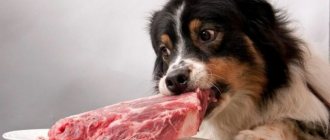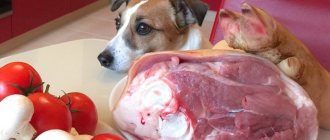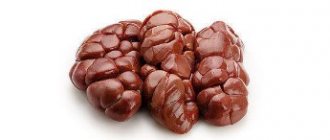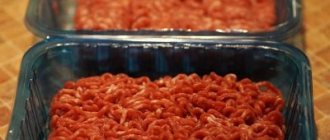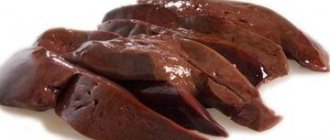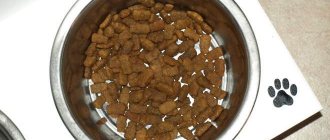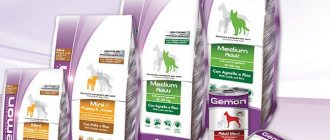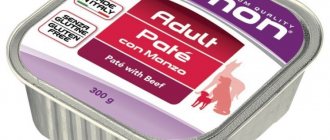Natural food for dogs is one of the possible feeding options, approved by veterinarians. It has its advantages and disadvantages, which it is recommended to familiarize yourself with before choosing the type of food. Taking into account all the features, you can create a balanced and healthy diet that guarantees the health of your pet.
Features of feeding dogs natural food
Natural dog food must not be mixed with dry food. If you choose this type of nutrition, then you will have to adhere to it throughout, if not the entire life of the animal, then a long part of it.
Advantages over dry food
The menu is based on a similar set of products, so basic cooking skills are enough to prepare. Self-cooking eliminates the presence of harmful components, since at the time of purchase you study not only the appearance, but also the composition.
All proteins and fiber in food are natural and are more easily absorbed by the body. This has a beneficial effect on the stomach and intestines. Thanks to the possibility of combining hard and soft dishes, dental health is maintained. Hard particles prevent the formation of caries, while soft particles are gentle on the gums.
Due to the simplicity of the recommended menu, the cost of food for representatives of large breeds is less than dry food. In case of illness, the diet is easier to adjust, since most therapeutic diets include regular foods.
Another argument in favor of natural food is that many owners like to feed their pet natural food. And the psychological comfort of the owner is an important matter.
Disadvantages and inconveniences
Disadvantages include the difficulty of complying with the KBZHU and the length of time it takes to prepare dishes. To replenish missing vitamins, you have to buy special dietary supplements, the cost of which can be quite high.
The pet will have to be fed exclusively with fresh dishes, which complicates long trips. Temporary transfer to dry food has a detrimental effect on the gastrointestinal tract, leading to diarrhea or constipation.
Most often, difficulties arise with representatives of small breeds. These dogs are whimsical and do not need large amounts of food. Because of this, the owner spends a lot of time looking for suitable dishes and constantly throws away half-eaten leftovers.
Useful tips
If your dog flatly refuses to eat fresh vegetables, then you can use a little trick. Lightly boiled or stewed vegetables may be to the taste of a picky four-legged pet.
Dog handlers advise excluding sweet, smoked, spicy, and salty foods from your pet’s diet. And under no circumstances should you mix natural menus and ready-made diets.
If absolutely necessary, the transition should be gradual so that the dog’s body can adapt. The duration of adaptation cannot be less than 14 days.
What foods are included in the diet
All recommended products are served in one dish. After cooking, mix them thoroughly. This is necessary for comfortable digestion, since homogeneous dishes of a similar temperature are digested at the same speed.
The basis of the diet is protein, that is, meat, offal and fish. Depending on the age, weight and breed of the dog, at least 50% is allocated to the meat component. Next come cereals - 30% and vegetables and fruits - 10%. 5-10% remains for fermented milk products and other additives (bran, oils).
Meat, fish and offal
Natural dog food is not complete without animal proteins. Which foods contain them in large quantities:
- Lean meats (beef, rabbit)
. Serve them raw or boiled, preferring the former. Feed poultry with caution, as it often causes allergic reactions. Meat rich in B vitamins is necessary for muscle growth and strengthening. Before serving, it is advisable to lightly scald raw meat with boiling water.
- Fish (perch, pollock, trout)
, cleared of bones. River varieties are served strictly after cooking to prevent infection by helminths. Marine species are safer, so after removing scales and entrails, they can be given raw or ground into minced meat. Frequent consumption of fish slows down the dog's growth, leads to digestive problems and dandruff. Include it in the menu no more than 2 times a week. The exception to the rule is dog breeds bred in Japan.
- By-products (liver, heart, tripe)
. Internal organs are useful, but require mandatory heat treatment. To be safe, you can pre-freeze them. A sharp temperature change is guaranteed to kill all parasites. Offal is fed no more than 3 times a week.
The listed animal proteins cannot be served together. Meat forms the basis, and fish and offal are served as a substitute several times a week. On such days, the usual volume of the protein component is increased by 1.5 times. That is, if you give 100 grams of meat, then on a fish day you need to give 150 grams of the protein component.
Additionally, you can give soft-boiled quail or chicken eggs and a protein omelet. It is not recommended to abuse such treats. Consuming more than 2 pieces per week is fraught with the development of diathesis.
Dairy products
When feeding a dog naturally, fermented milk products must be included in the dog’s diet: yogurt, cottage cheese, kefir. Choose products without additives with a short shelf life and low fat content. This will eliminate the presence of dangerous preservatives and problems with stool.
Fermented milk and meat products are served separately from each other. You can add a little bran to kefir or yogurt to stimulate intestinal function.
Cereals
Proper nutrition is not complete without cereals. Rice, buckwheat and rolled oats are good for the dog's body. You need to be careful with the last grain. It is forbidden to use whole grains, and also to give rolled oats too often - this can lead to inflammation of the anal glands.
Porridges are boiled in water, meat or vegetable broth until soft and homogeneous. Before serving, add meat, vegetables and a little vegetable oil (linseed, olive).
In addition to cereals, your pet can be fed a small amount of gray bread (50-100 g per day). White bread is harder to digest, so it is given only in the form of crackers and rather as a treat.
Fruits and vegetables
Unsweetened fruits (apples, pears) or dried fruits are served to the pet as a treat. They are not the main course, but can be used as a reward. From vegetables it is recommended to give:
- carrots;
- tomatoes;
- pumpkin;
- cabbage (raw, boiled or pickled);
- beets;
- zucchini;
- potatoes (strictly raw).
Additionally, include fresh herbs in the menu: lettuce, dill, parsley. If the dog walks freely in the garden beds during the summer season, the amount of plant components will have to be controlled. Their excess can lead to diarrhea.
Is it possible to give bones?
Bones are a good tool for preventing tartar. The cartilage they contain is rich in collagen, which is essential for healthy joints and ligaments. Despite the obvious benefits, there are a number of important nuances to eating bones.
Well-cooked tubular and rib bones, when chewed, break into many small fragments, injuring the esophagus and intestines. Due to the abundance of gluten that appears after cooking, intestinal obstruction may occur.
Only porous and spongy bones (shoulder, brisket) can be added to the diet in raw form. It’s even safer to limit yourself to chewing toys or artificial bones from pet stores and veterinary pharmacies.
Prohibited foods for dogs
Feeding a dog natural food is not always safe. Some foods should be avoided. These include:
- smoked meats and spices (only salt is allowed, which normalizes the water-salt balance);
- onions and garlic, which cause anemia;
- pork, which is fraught with obesity and helminth infection;
- sorrel, which causes acute gastritis;
- legumes, pearl barley and millet, which provoke flatulence due to poor digestibility;
- fruits and berries with seeds, which are fraught with disruptions in the gastrointestinal tract;
- citrus fruits, semolina and confectionery products, which often cause allergies;
- mushrooms, grapes and raisins, which are fraught with acute intoxication and the development of renal failure;
- pasta and baked goods that provoke rapid weight gain;
- tubular and small bones that can damage the walls of the esophagus or intestines.
Remember that milk is contraindicated for adult animals. After a year they develop lactose intolerance.
How to properly feed your dog natural food
For your pet's health, it is important to monitor the frequency of feedings and the volume of portions. Eating too rarely is fraught with gastrointestinal disorders, and eating too often can lead to weight gain.
To calculate individual norms, you can use the table below. With its help, you can easily select a weekly menu based on the characteristics of your pet.
Feeding mode
Adult animals over 1 year old are fed twice a day: morning and evening. During free hours, the stomach has time to digest all the food received, which eliminates the feeling of heaviness. A longer break is not recommended, as the dog will begin to experience an acute feeling of hunger. During a therapeutic diet, the frequency of feedings is increased in favor of reducing the volume of single servings.
Puppies are fed much more often:
- 6-8 times up to 2 months;
- 5-6 times from 2 to 3 months;
- 3-4 times from 3 to 6 months;
- 3 times from 6 to 12 months.
The daily portion is divided into the required number of doses in equal or unequal proportions. Here it is better to build on the preferences of your pet. After a night's sleep, many people like to eat a hearty meal, so the morning portion can be made a little larger.
Giving food right before a walk is not recommended. Due to the heaviness, it will be uncomfortable for the pet to move and exercise. And disobedient dogs that tend to run away will be kept from doing so by the feeling of hunger. It is safer to take an hour break after eating or to feed the dog immediately after returning from the street.
Serving Size Calculation
In addition to health status, portion size is affected by age and weight. Puppies need to eat 6-7% of their body weight, and adult dogs - 3-5%. Regarding calories, veterinarians recommend taking into account either age (for puppies) or breed (for adult animals):
- 220 kcal per 1 kg up to 2 months, 265 kcal – from 2 to 3 months, 201 kcal – from 3 to 4 months, 136 kcal – from 4 to 8 months, 100 kcal – from 8 to 12 months;
- 53 kcal per 1 kg for giant breeds, 60 kcal for large breeds, 69 kcal for medium-sized ones, 84 kcal for small breeds, 110 kcal for dwarf breeds.
EXAMPLE: Based on average indicators, you can calculate the norms for a husky - a six-month-old puppy weighing 15 kg and an adult dog weighing 25 kg.
| Age | Weight, kg) | Meat (55%) | Fermented milk products (30%) | Cereals (10%) | Fruits and vegetables (5%) | Total caloric content of daily portion |
| Puppy | 15 | 1122 kcal | 612 kcal | 204 kcal | 102 kcal | 2040 kcal |
| Adult animal | 25 | 949 kcal | 517 kcal | 173 kcal | 86 kcal | 1725 kcal |
Thanks to simple formulas, you can easily calculate the indicator for your pet in calories or grams. Please note that the totals are for general guidance only and are subject to change at the discretion of your veterinarian. Depending on existing problems or lifestyle, your pet may be able to reduce or increase calories, as well as change the ratio of fats, proteins and carbohydrates.
Sample menu for the week
Feeding dogs natural food with a pre-selected menu makes choosing food and preparing meals easier. You can take ideas for breakfast and dinner from the table.
| Day of the week | Breakfast | Dinner |
| Monday | Beef stew with pumpkin and carrots | Minced chicken with rice |
| Tuesday | Beef heart with rice and zucchini | Oatmeal seasoned with fermented baked milk |
| Wednesday | Boiled perch with raw cabbage and potatoes | Cottage cheese with dried apricots |
| Thursday | Chicken meatballs with buckwheat porridge and boiled beets | Ryazhenka with fresh carrot and cabbage salad dressed with linseed oil |
| Friday | Rabbit meat with rice and tomatoes | Meat broth with turkey meatballs |
| Saturday | Buckwheat with boiled pollock, seasoned with olive oil | Oatmeal seasoned with fermented baked milk or kefir |
| Sunday | Tripe with rice and stewed pumpkin | Boiled liver with stewed cabbage |
Despite the possible variety, try to keep the diet as simple as possible. Otherwise, the pet will begin to be picky. The chosen menu can be followed throughout your life.
Also try not to introduce new dishes on the same day of the week. This will help track down the source of allergies or digestive problems if such are suspected.
Pet recipes for every day
There are many recipes for feeding dogs naturally. I will give a few examples that you can take as a basis and change to suit your pet’s taste.
Beef heart porridge
- heart – 1 kg.
- rice – 150 gr.
- carrots – 1 pc.
- zucchini – 0.5 pcs.
- vegetable oil – 1 tbsp. l.
Boil the heart for 20 minutes. Cut the vegetables into cubes or grate them. Boil the rice. Mix all ingredients when cooled to room temperature.
The daily natural feeding rate is calculated based on the pet’s weight
Vegetable stew with meat
- minced meat or stewed meat – 500 g
- boiled vegetables (carrots, cabbage, pumpkin) – 200 g
- cottage cheese – 100 g
- raw egg – 2 pcs.
Mix everything.
Chicken hearts with apples and carrots
- chicken hearts – 1 kg
- apple – 1 pc.
- carrots – 1 pc.
Boil the hearts. Grate the apple and carrots on a coarse grater and bake in the oven for 5 minutes. Combine everything and stir well.
Cold cuts
- any offal (heart, tripe, trachea, etc.)
Cut the meat into pieces and boil for 20 minutes. Drain the water.
Meat stew for dogs
Features of feeding puppies natural food
Babies up to 2 months feed on mother's milk. The use of ready-made formulas is permissible only if breastfeeding is impossible. Mixtures can be purchased at pet stores and veterinary pharmacies. Please note that cow or goat milk can only be used as an emergency option for a couple of days - the milk of these animals is different from dog milk, so it lacks some of the vitamins necessary for the puppy's health.
The first complementary foods are given at 3 weeks. All food (cereals, meat, vegetables) must be ground into pulp. Fermented milk products are introduced after 1.5 months, giving them several times a day. Homemade cottage cheese made from milk and kefir is good for strengthening children's bones.
From 4 months, yoghurt, kefir and cottage cheese are fed no more than once a day. Also, from this age it is allowed to give fresh cabbage. Before this time, it must be boiled. Additionally, you can include sea fish in your diet.
For up to six months, be sure to grind the rolled oats before serving. After changing teeth, be careful when removing bones - sharp molars can crush them into small fragments.
Monitor your weight gain regularly. If the indicator is too high or low, reconsider your diet.
Mode
The amount of food for a pet’s daily diet is calculated based on the age and weight of the animal:
- Puppy - 5-10% of weight;
- Teenager - 3-5% of weight;
- Adult dog - 2-3% of weight.
For obese dogs, the daily food intake should not exceed 1-2% of the animal's weight. These values are average and are suitable for pets leading a sedentary lifestyle. If a dog spends his days actively, then for his body to function properly, these indicators need to be increased. The number of calories in the diet needs to be increased during special periods of a dog’s life - gestation of puppies and the period of feeding them.
Vitamin supplements and complexes
Among natural ingredients, it is recommended to use fish oil, raw seaweed, crushed eggshells, wheat germ flour and brewer's yeast. These popular sources of vitamins normalize intestinal microflora, strengthen bones and improve coat quality.
The amount of vitamin the animal needs is clarified by the veterinarian after testing. In addition to the options listed, you can choose vitamin complexes in tablet form. They will help balance the amount of useful elements not received from food.


